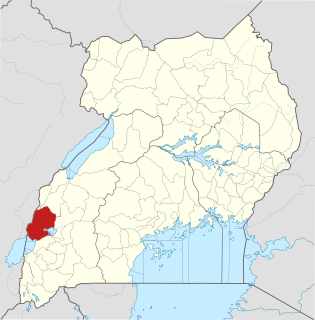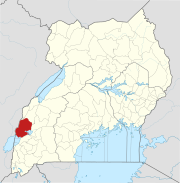
The Karuma Hydroelectric Power Station is a 600 MW hydroelectric power project under construction in Uganda. When completed, it will be the largest power-generating installation in the country.

Bugoye Power Station is a 13 MW (17,000 hp) mini hydroelectric power station in Uganda. In the literature, Bugoye Power Station is sometimes referred to as Mubuku II Power Station.

Mubuku III Power Station is a 10 megawatts (13,000 hp) mini-hydroelectric power station in Uganda.

Nshyugyezi Hydroelectric Power Station, also Nsongezi Hydroelectric Power Station, is a planned 39 megawatts (52,000 hp) hydroelectric power station in Uganda. The power project is under development, as of September 2017.

Nyamwamba Hydroelectric Power Station, also referred to as Nyamwamba Power Station, is a 14 megawatts (19,000 hp) mini-hydroelectric power station under construction in Uganda.

Lubilia Hydroelectric Power Station, also Lubilia Kawembe Power Station, is a 5.4 MW hydroelectric power station in Uganda, the third-largest economy in the East African Community.

Adekokwok Hydroelectric Power Station is an 8 megawatts (11,000 hp) mini hydroelectric power project in Uganda.

Achwa 3 Hydroelectric Power Station, also Achwa 3, is a proposed 10 MW (13,000 hp) hydroelectric power project in Uganda.
The Fort Portal–Kasese–Mpondwe Road also Fort Portal–Mpondwe Road, is a road in the Western Region of Uganda, connecting the towns of Fort Portal, Hima, Kasese, Kikorongo and the border town of Mpondwe.

Kibiito is a town in the Western Region of Uganda. It is the chief administrative center of Bunyangabu District, and the district headquarters are located there.

Rubona is a town in the Western Region of Uganda.

Nkusi Hydroelectric Power Station, also referred to as Nkusi Power Station, is a 9.6 MW (12,900 hp) hydroelectric power station under construction in the Western Region of Uganda.

Kyambura Hydroelectric Power Station, commonly referred to as Kyambura Power Station, is a 7.6 megawatts (10,200 hp) mini hydropower station under construction in Uganda.

Nyamagasani I Hydroelectric Power Station, also Nyamagasani 1 Hydroelectric Power Station is a 15 megawatts (20,000 hp) hydroelectric power project, under construction in Uganda.

Ndugutu Hydroelectric Power Station, also Ndugutu Power Station, is a proposed 4.8 MW (6,400 hp) mini-hydropower station in the Western Region of Uganda.

Sindila Hydroelectric Power Station, also Sindila Power Station, is a 5.25 MW (7,040 hp) mini-hydropower station under construction in the Western Region of Uganda.

Nyamagasani II Hydroelectric Power Station, also 'Nyamagasani 2 Hydroelectric Power Station, is a 5 megawatts (6,700 hp) mini hydro power station, under construction in the Western Region of Uganda.










